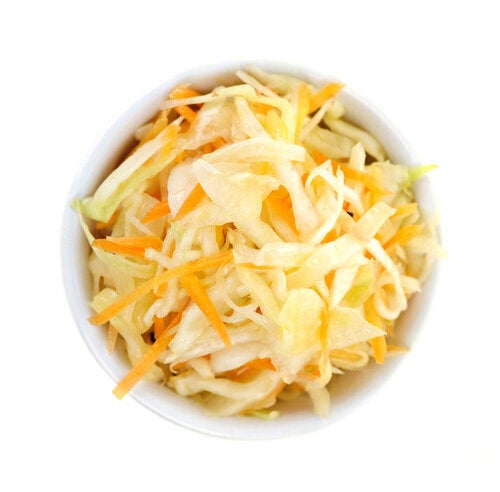
It's downright clitoral --- that sensitive, robust head hidden beneath the leaves, packed with positive energy just waiting to be released. Indeed, cabbage, like other cruciferous vegetables, is filled with anti-cancer compounds, but you have to know how to handle it to reap the special rewards.
I recently conducted an email interview with food scientist Dr. Paul Thornalley, of the University of Warwick, who has lots of advice for us consumers.
Rule #1: Keep the touch gentle. Eat cabbage raw or lightly cooked.
Cooking cabbage at high temperatures for prolonged periods destroys the active enzyme myrosinase, needed to turn compounds called glucosinolates into others called isothiocyanates, which in turn are responsible for the anti-cancer actions.
Translation please? Cabbage rolls just won't deliver the goods. In fact, by boiling leaves in water, Thornalley says, the healthy glucosinolates will end up in the liquid.
Rule #2: When you cut cabbage, make sure the pieces are fairly large -- a centimetre or more. (That's a little less than half an inch, and yes, that's big). Smaller cuts, says Dr. Thornally, will destroy the enzyme's ability to create that cascade of actions.
Rule #3: Don't let cut cabbage sit on the counter for more than two to three hours.
It will lose its magic compounds. Instead, keep cut cabbage in the fridge, where the compounds should last for several days, he says.
So if you're not counting on cabbage rolls or finely-shredded coleslaw for your daily dose of cancer-fighting crucifers, what can you do with that hardy head of cabbage instead? Here are some ideas (from my humble kitchen, not Thornalley's lab):
BLOG CONTINUES BELOW SLIDESHOW
•Chunky Coleslaw -- Dress it with extra virgin cold pressed olive oil and a little vinegar. Add scallions, cut on the diagonal, and some caraway or cumin seeds. For an Asian vinaigrette, use a dash of cold sesame oil.
•Steamed cabbage -- Use a steamer and a little bit of water, and cook quickly. Then add some tasty seeds or sauce. Or throw the plain steamed cabbage into a bowl of already-cooked soup (instead of cooking it for a long time with the soup, which will destroy the essential enzymes.)
•Lightly sautéed cabbage -- Saute briefly in olive oil on low to medium heat. Place the mixture inside a lettuce wrap with some other veggies and an Asian-inspired dressing or use as the base for a moo shu platter.
•Sauerkraut -- It's simply raw cabbage that's been fermented, meaning healthy bacteria are added, which increases the cancer-fighting properties. Look for local brands that haven't been pasteurized (heated in order to destroy germs.) Or make your own. For a more potent anti-cancer recipe, add some extra turmeric to mustard and mix with the kraut.
•Kimchi- -- fermented cabbage, Korean style. Find a local supplier who doesn't use loads of sugar to counter the intensity. And be forewarned: Korean red pepper powder can be explosive. Once again, a light touch prevails!
